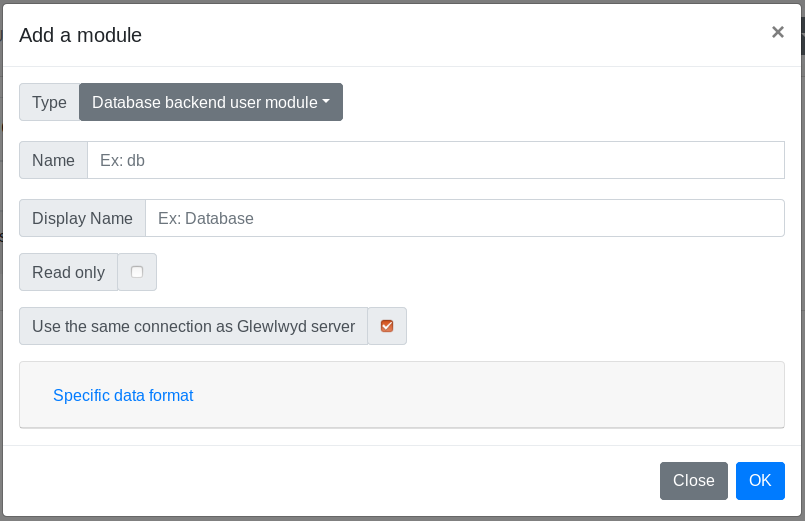Glewlwyd User Module Database Backend documentation

The database backend uses a database to store information and passwords for users. The database can be the same one as the Glewlwyd database or another database of another supported type.
Installation
In the administration page, go to Parameters/Users data sources and add a new user module by clicking on the + button. In the modal, enter a name and a display name (the name must be unique among all user backend instances).
Select the type Database backend user module in the Type drop-down button.
Below is the definition of all parameters.
Name
Name (identifier) of the module instance, must be unique among all the user backend module instances, even of a different type.
Display name
Name of the instance displayed to the user.
Read only
Check this option if you want to use this backend as read-only. All user properties such as e-mail, name, password, scopes can’t be modifier with Glewlwyd, even administrators.
PKBDF2 iterations (SQLite3)
Number of iterations for the password digest in SQlite3 databases only. Currently (2021), it’s recommended to iterate at least 100 000 times.
Multiple password
Check this option if you allow users to manage multiple passwords. More information about multiple passwords use-cases are avaiable in the Getting Started Dcumentation.
Use the same connection as Glewlwyd server
Uncheck this option if you want to use a different database that will store the users. The new database must have the structure already present. Use one of the following script to initialize the database:
- MariaDB: database.mariadb.sql
- Postgre SQL: database.postgre.sql
- SQLite 3: database.sqlite3.sql
Database type
This option is available if the option Use the same connection as Glewlwyd server is disabled.
Select the database backend among the ones available.
Path to the database (SQLite 3)
This option is available if the database type selected is SQLite 3. Enter the path of the SQLite 3 database on the server.
Host (MariaDB/MySQL)
This option is available if the database type selected is MariaDB/MySQL. Hostname of the MariaDB/MySQL server.
Username (MariaDB/MySQL)
This option is available if the database type selected is MariaDB/MySQL. Username to connect to the MariaDB/MySQL server.
Password (MariaDB/MySQL)
This option is available if the database type selected is MariaDB/MySQL. Password to connect to the MariaDB/MySQL server.
Database name (MariaDB/MySQL)
This option is available if the database type selected is MariaDB/MySQL. Name of the database hosting the Glewlwyd user backend tables.
TCP Connection port (0: system default) (MariaDB/MySQL)
This option is available if the database type selected is MariaDB/MySQL. TCP Port used to connect to the MariaDB/MySQL database. Set 0 if you want to use default system port.
Postgre SQL connection string (PostgreSQL)
This option is available if the database type selected is PostgreSQL. SQL Connection string used to connect to the PostgreSQL database.
Specific data format
This section allows to specify new properties for the user. The properties may be available for schemes, plugins, in the admin page or in the profile page.
Property
Property name, ex: phone, address, human, etc.
Multiple values
If this option is checked, the property values will be available as an array of string values, otherwise a single string value.
Read (admin)
If this option is checked, plugins, schemes and administrators can have access to this property in read mode.
Write (admin)
If this option is checked, plugins, schemes and administrators can have access to this property in write mode.
Read (profile)
If this option is checked, the user can have access to this property in read mode in its profile API.
Write (profile)
If this option is checked, the user can have access to this property in write mode in its profile API.
